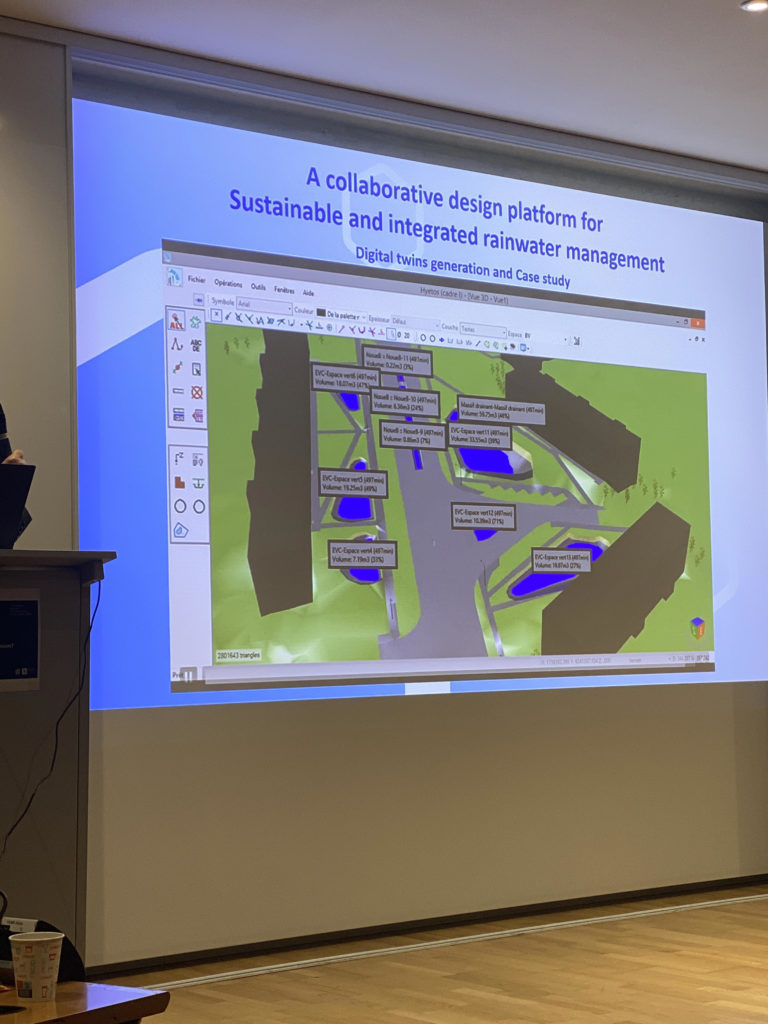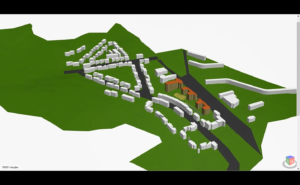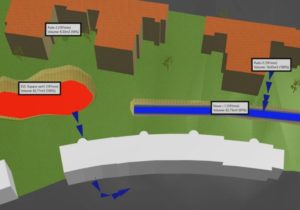Kea.Polaris, un logiciel hydraulique générateur de jumeaux numériques
Kea.Polaris, un jumeau numérique au service de la gestion durable et intégrée des eaux pluviales
CDI Tech a participé au colloque SimHydro 2023 organisé du 8-10 novembre par la SHF (Societe Hydrotechnique de France et consacré aux nouveau paradigmes de modélisa pour les problématiques de l’eau
Elle a présenté un article sur la création de jumeaux numériques par kea.Polaris avec comme cas d’usage, la gestion durable et intégrée des eaux pluviales à l’échelle du projet et du quartier. « Une plateforme collaborative de conception pour une simulation prospective de la gestion durable des eaux pluviales – Génération de jumeaux numériques et cas d’étude »
The consideration of stormwater management is often overlooked as a potential lever to enhance urban sustainability. The intensive urbanization of our cities significantly contributes to the increase in runoff water which gives rise to issues such as pollution and flooding.
By collecting raindrop where it falls, sustainable and integrated stormwater management succeeds in minimizing the spread of pollution while preserving the natural water cycle. Additionally, by accommodating water on the surface and making it fit the landscape, it promotes the return of nature to the urban environment. Lastly, by preventing runoff from reaching the sewage systems, it averts the energy waste associated with transferring and treating stormwater. This approach reduces the risks of flooding, limits the discharge of untreated effluents into receiving environments, thereby helping to mitigate associated health hazards.
However, despite its undeniable advantages, numerous barriers continue to hinder the widespread diffusion and adoption of this approach in urban design practices. Several intricate factors contribute to explaining this persistent reality. Firstly, among design and construction professionals there remains a lack of deep understanding of this sustainable management, primarily due to the long-standing habit of considering these waters as a constraint to be discreetly managed underground far from the eyes of city-dwellers. The transition to the vision of urban stormwater as a valuable resource necessitates a paradigm shift as well as new collaborations among stakeholders not accustomed to working together. While sanitation historically fell under the purview of technical services, it’s now imperative for landscape architects, architects, and urban planners to also get involved and take ownership of stormwater management.
The widespread implementation of sustainable stormwater management within communities as well as among design and construction professionals therefore calls for a reorganization of skills across various professions and a strengthening of collaboration among the numerous stakeholders involved.
It quickly became evident that the most suitable solution to achieve these objectives would be the utilization of computer-aided design software. This software would enable all stakeholders involved in the urban layout project to collaborate, integrating and highlighting sustainable stormwater management solutions from the project’s initial phases throughout its evolution. Our aim was to create a collaborative design platform that transcended the mere technical aspect traditionally associated with the sanitation engineer’s role. This platform would encompass various other dimensions: hydrological (taking into account the watershed), landscape-oriented (attach great importance to the layout of the space), social (embracing a multi-purpose approach), and economic (reducing construction costs and expenses linked to stormwater transport and treatment).

The project, initiated in 2016, aimed to create a tool that enhances the skills of designers, facilitates collaboration among various stakeholders, improves communication between designers and project owners, and raises awareness about sustainability while involving citizen participation. The overarching goal was to promote sustainable and ecological urbanization by effectively incorporating aspects related to stormwater management.
It was through a multidisciplinary team that this project was implemented, leading to the creation of the Hyetos module within the Kea.Polaris software.
Hyetos (Kea.Polaris) is a collaborative platform that enables the sizing of sustainable stormwater management solutions, simulation and visualization of their performance for various rainfall events.
It also permits the generation of a digital twin of the layout project simulating sustainable stormwater management in urban areas and along road projects for prospective scenarios. This includes visualizing runoff, studying layout project variants and assessing their resilience in the face of extreme events.
The platform was evaluated and validated on a redevelopment project for Charles de Gaulle Avenue and its surrounding structures, located in the municipality of Saint-Saulve (Valenciennes Métropole, Département du Nord, France) covering a total area of approximately 2.5 hectares.
The aim of this urban redevelopment was to transform the traditionally mineral image of the neighbourhood by creating pathways where the presence of mineral surfaces would be significantly reduced in favour of vegetated spaces. This approach would enable sustainable stormwater management, putting an end to recurrent flooding, while promoting harmony and the landscape integration of the project.
This R&D project, by bringing together actors from various disciplines, aims to address increasingly stringent institutional requirements for professionals in urban design and construction. These stakeholders must now develop new skills or engage external experts to adapt to current developments and anticipate forthcoming environmental challenges. The collaboration among researchers from diverse, sometimes very distinct, fields has led us to establish a shared workspace in which we could exchange ideas and devise joint action strategies. This collaborative approach has resulted in the creation of this software, which we hope will serve as a vehicle for disseminating solutions for sustainable stormwater management. Moreover, it should facilitate the acquisition of new skills and the


